DIY shade cloth
Escape the hot summer sun with this nifty shade cloth, which can be folded down and stored away easily come winter.
You will need: 19mm galvanised clouts, 45mm exterior screws, 65mm exterior screws, 50mm x 50mm timber (approx 16500mm), 50mm x 25mm timber (approx 1650mm), 40mm x 10mm timber (approx 3300mm), 100mm x 25mm timber (approx 1700mm), 150mm x 50mm timber (approx 250mm), 100mm x 10mm bolts with wingnuts and washers (x2), canvas measuring 1050mm x 1550mm, clamp, drill with 3mm drill bit and 10mm drill bit, exterior PVA glue, paint stirrer, paintbrush, pencil, Resene Lumbersider tinted to Resene Half Parchment, Resene Quick Dry, sandpaper, saw, screwdriver, set square, small stainless-steel hinges (x6), staple gun with galvanised staples, tape measure.
Top tip: To store away for the winter, simply unbolt the front support and then let the canvas hang down against the back of the frame and fold the two side frames in towards the middle.
To get the look: Mark painted the background stucco wall with Resene Aquashield tinted to Resene Pipi.

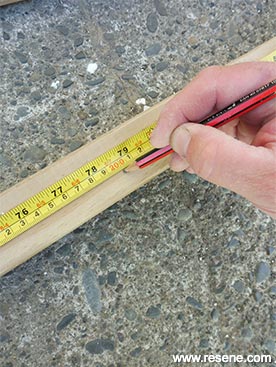 Step one
Step one
Measure and mark the 50mm x 50mm timber to these lengths: 1640mm (x 2), 2000mm (x 4), 1800mm (x 2), and 800mm (x 2).
 Step two
Step two
Use the back of the saw to rule cutting lines.
 Step three
Step three
Cut the pieces of 50mm x 50mm timber to length and smooth rough edges with sandpaper.
 Step four
Step four
From the offcut of 50mm x 50mm timber cut two triangles, as shown, with the equal sides measuring 120mm. Smooth rough edges with sandpaper.
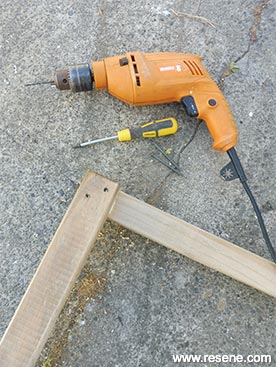 Step five
Step five
Attach two of the 2000mm lengths of timber to the two 1640mm lengths of timber to form a large rectangular frame. Fix at each corner with exterior PVA glue and 65mm screws, drilling pilot holes first.
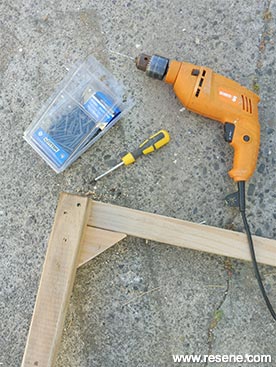 Step six
Step six
Fix the triangular pieces of wood into the top corners of this frame, fixing with PVA glue and 65mm screws, drilling pilot holes first. Use a set square to ensure corners are at 90 degrees.
 Step seven
Step seven
Fix a 2000mm length of timber and a 1800mm length of timber to a 800mm length of timber to form a ‘U’ shape. Fix at each corner with 65mm screws and PVA glue, drilling pilot holes first. Again use a set square to ensure corners are true. With the remaining timber, form a second ‘U’ shape and allow glue to dry.
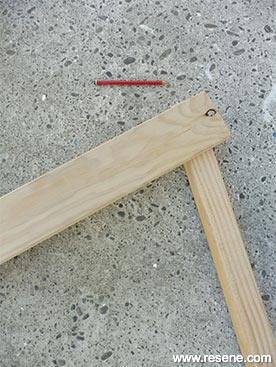 Step eight
Step eight
Lay a piece of 100mm x 25mm timber across the top of each of these ‘U’ shapes (it will be at an angle) and rule angled cutting lines.
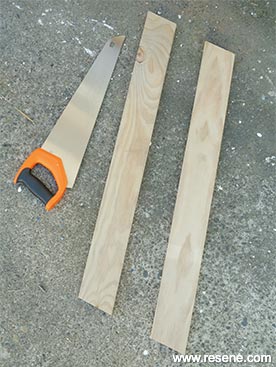 Step nine
Step nine
Cut these pieces to shape and smooth rough edges with sandpaper. Fix into position across the top of the ‘U’ shapes with 45mm screws and PVA glue, drilling pilot holes first. Allow glue to dry
 Step ten
Step ten
Measure, mark and cut a 1640mm and 1648mm piece of 40mm x 10mm timber and a 1648mm piece of 50mm x 25mm timber.
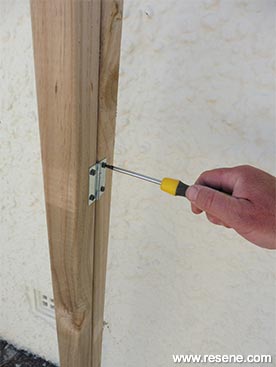 Step eleven
Step eleven
Fix the two smaller side frames to the larger frame at the back using three small hinges per side.
 Step twelve
Step twelve
Carefully stir the Resene Quick Dry.
 Step thirteen
Step thirteen
Stand the frame on four offcuts of 50mm x 50mm timber and apply one coat of Resene Quick Dry to the frame and the three pieces of timber cut in step ten. Allow two hours to dry.
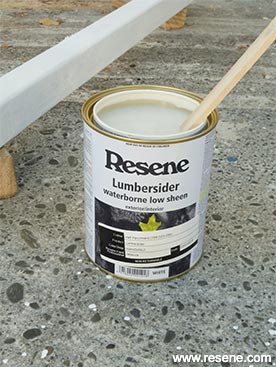 Step fourteen
Step fourteen
Carefully stir the Resene Lumbersider tinted to Resene Half Parchment.
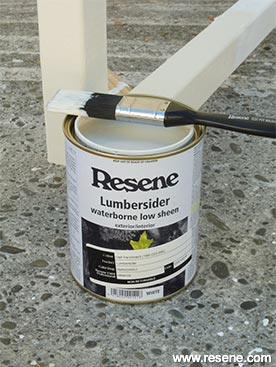 Step fifteen
Step fifteen
Apply two coats of the Resene Lumbersider to the frame and the three pieces of timber cut in step ten. Allow two hours for each coat to dry
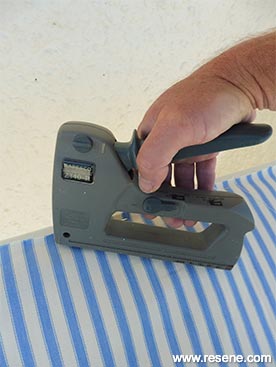 Step sixteen
Step sixteen
Staple the piece of canvas along the top back edge of the frame, as shown. Staple the opposite edge to the 1648mm piece of 50mm x 25mm timber.
 Step seventeen
Step seventeen
Place the two pieces of pre-cut 40mm x 10mm timber over the stapled edges and fix with PVA glue and 19mm galvanised clouts.
 Step eighteen
Step eighteen
Tighten the canvas by rolling the front support around once and then clamp into position at each side. Drill a 10mm hole through all sections, as shown and fix with a 100mm bolt, washer and wingnut. Repeat on the other side.
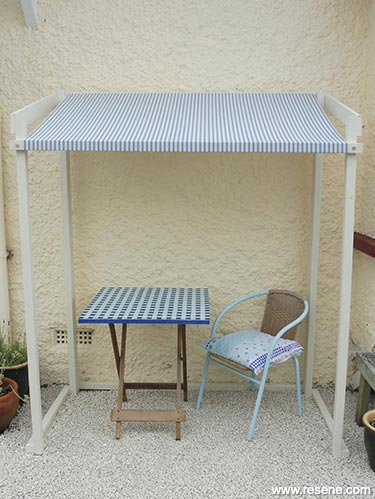
 Step one
Step one  Step two
Step two  Step three
Step three  Step four
Step four Step five
Step five  Step six
Step six  Step seven
Step seven  Step eight
Step eight  Step nine
Step nine Step ten
Step ten Step eleven
Step eleven Step twelve
Step twelve Step thirteen
Step thirteen Step fourteen
Step fourteen Step fifteen
Step fifteen Step sixteen
Step sixteen Step seventeen
Step seventeen Step eighteen
Step eighteen